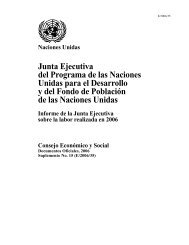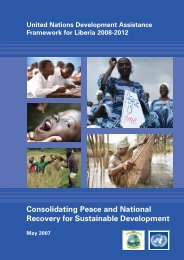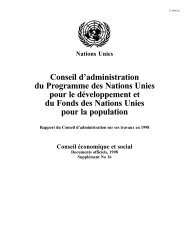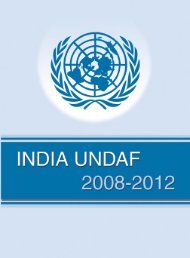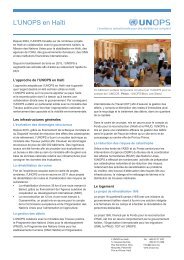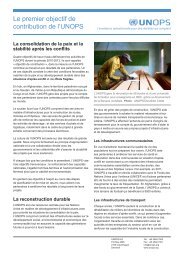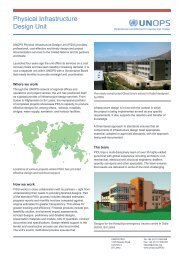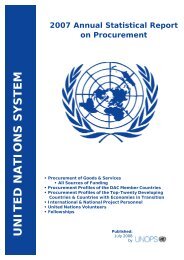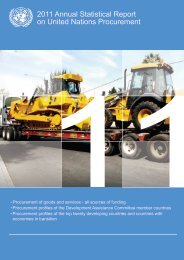English - UNOPS
English - UNOPS
English - UNOPS
You also want an ePaper? Increase the reach of your titles
YUMPU automatically turns print PDFs into web optimized ePapers that Google loves.
E/2004/35<br />
outlined by the United Nations General Assembly Special Session on HIV/AIDS.<br />
She concluded by informing delegations that UNAIDS would provide more detailed<br />
information at the annual session of the Board in June.<br />
92. The Executive Board adopted decision 2004/5 on UNDP follow-up to the<br />
UNAIDS Programme Coordinating Board meeting.<br />
United Nations Population Fund<br />
93. The Chief of the HIV/AIDS Branch, UNFPA, introduced the report entitled<br />
UNFPA Response: Implementing the UNAIDS Programme Coordinating Board<br />
recommendations of June 2003 (DP/FPA/2004/5).<br />
94. Delegations welcomed the opportunity to consider on a regular basis the UNFPA<br />
response to recommendations of the UNAIDS Programme Coordinating Board<br />
(PCB) and noted that it would contribute to a more harmonized and coherent United<br />
Nations system response to the HIV/AIDS epidemic. Emphasizing that coordination<br />
was vital in addressing the epidemic, delegations urged strengthening of countrylevel<br />
coordination among UNAIDS co-sponsors. Noting that future reports should<br />
be more analytical, delegations asked that they include an examination of how<br />
UNAIDS co-sponsors complement and support each other and how UNAIDS<br />
contributes to their HIV/AIDS work, including with regard to programme design.<br />
Delegations were interested in knowing what UNFPA could do to scale up national<br />
HIV-prevention strategies – including ensuring condom security – within poverty<br />
reduction strategies. Given the feminization of the epidemic, delegations stressed<br />
promoting women’s reproductive health and rights and ensuring access to<br />
reproductive health services. Some delegations noted that it was not clear if the<br />
activities reported were those that were already under way or if they were the result<br />
of a structured response to PCB decisions. Additional information was requested on<br />
follow-up to PCB recommendations and it was suggested that relevant PCB<br />
decisions be annexed to future reports.<br />
95. The Chief, HIV/AIDS Branch, UNFPA, appreciated the constructive comments<br />
and assured the Executive Board that UNFPA would provide additional information<br />
at the annual session. She noted that several mechanisms contributed to<br />
complementarity, including the UNAIDS unified budget and work plan; the interagency<br />
task teams; the convening agency modality within which co-sponsors<br />
worked together to map out actions, track activities and better coordinate the United<br />
Nations response; and the resident coordinator system. UNFPA held the convening<br />
role in two areas, young people and condom programming, and co-chaired the<br />
gender task team with UNIFEM. Although the Fund did not have the resources to<br />
scale up, it had documented processes and identified critical elements that countries<br />
could utilize for effective scaling up using other funding sources. Emphasizing that<br />
it was not business as usual, she underscored that UNFPA was now focusing<br />
attention on meeting the reproductive health needs of HIV-positive women. She<br />
noted that within the last six months UNFPA had identified HIV/AIDS focal points<br />
in all its country offices. Also, the virtual inter-divisional working group was<br />
holding discussions on HIV/AIDS via the Internet.<br />
15




